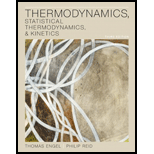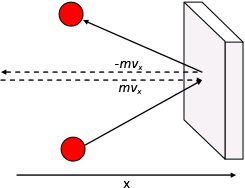
Thermodynamics, Statistical Thermodynamics, & Kinetics
3rd Edition
ISBN: 9780321824004
Author: ENGEL, Thomas/ Reid
Publisher: Pearson College Div
expand_more
expand_more
format_list_bulleted
Question
Chapter 1, Problem 1.12CP
Interpretation Introduction
Interpretation:
The reason for no change in the z and y components of the velocity in the collision needs to be explained.

Concept Introduction:
The theory of collision explains that for a
Expert Solution & Answer
Want to see the full answer?
Check out a sample textbook solution
Students have asked these similar questions
Design experiments in UV-Vis to figure the optimal mole ratio of copper (1:1, 2:1, 3:1 and etc)versus ethambutol using all necessary chemicals including dihydrochloride and copper nitrate hemipentahydrate and sodium hydroxide. Show how UV-Vis absorbance and maximum wavelength would change in response
Correct each molecule in the drawing area below so that it has the condensed structure it would have if it were dissolv
a 0.1 M aqueous solution of HCI.
If there are no changes to be made, check the No changes box under the drawing area.
No changes.
HO—CH,—C—CH,—OH
X
5
2
2
2
HO–CH,—CH,—C—CH,—OH
Explanation
Check
Center Accessi
©2025 on
5
C
Make the calculations to prepare 2M H2SO4, from concentrated H2SO4 (98%; density: 1.84 g/mL).
Chapter 1 Solutions
Thermodynamics, Statistical Thermodynamics, & Kinetics
Ch. 1 - Real walls are never totally adiabatic. Use your...Ch. 1 - The parameter a in the van der Waals equation is...Ch. 1 - Give an example based on molecule—molecule...Ch. 1 - Prob. 1.4CPCh. 1 - Prob. 1.5CPCh. 1 - The location of the boundary between the system...Ch. 1 - Prob. 1.7CPCh. 1 - At sufficiently high temperatures, the van der...Ch. 1 - Prob. 1.9CPCh. 1 - Prob. 1.10CP
Ch. 1 - Prob. 1.11CPCh. 1 - Prob. 1.12CPCh. 1 - Prob. 1.13CPCh. 1 - The mass of a He atom is less than that of an Ar...Ch. 1 - Prob. 1.15CPCh. 1 - Prob. 1.1NPCh. 1 - A compressed cylinder of gas contains 2.74103g of...Ch. 1 - Calculate the pressure exerted by Ar for a molar...Ch. 1 - A sample of propane C3H8 is placed in a closed...Ch. 1 - A gas sample is known to be a mixture of ethane...Ch. 1 - One liter of fully oxygenated blood can carry 0.18...Ch. 1 - Yeast and other organisms can convert glucose...Ch. 1 - A vessel contains 1.15 g liq H2O in equilibrium...Ch. 1 - Consider a 31.0 L sample of moist air at 60.C and...Ch. 1 - Prob. 1.10NPCh. 1 - Prob. 1.11NPCh. 1 - A rigid vessel of volume 0.400m3 containing H2 at...Ch. 1 - A mixture of oxygen and hydrogen is analyzed by...Ch. 1 - An athlete at high performance inhales 3.75L of...Ch. 1 - Devise a temperature scale, abbreviated G, for...Ch. 1 - Aerobic cells metabolize glucose in the...Ch. 1 - Prob. 1.17NPCh. 1 - A mixture of 2.10103g of O2, 3.88103mol of N2, and...Ch. 1 - Prob. 1.19NPCh. 1 - Prob. 1.20NPCh. 1 - An initial step in the biosynthesis of glucose...Ch. 1 - Prob. 1.22NPCh. 1 - Assume that air has a mean molar mass of 28.9gmol1...Ch. 1 - When Julius Caesar expired, his last exhalation...Ch. 1 - Calculate the number of molecules per m3 in an...Ch. 1 - Prob. 1.26NPCh. 1 - A mixture of H2 and NH3 has a volume of 139.0cm3...Ch. 1 - A sealed flask with a capacity of 1.22dm3 contains...Ch. 1 - A balloon filled with 11.50 L of Ar at 18.7C and 1...Ch. 1 - Carbon monoxide competes with oxygen for binding...Ch. 1 - The total pressure of a mixture of oxygen and...Ch. 1 - Suppose that you measured the product PV of 1 mol...Ch. 1 - Liquid N2 has a density of 875.4kgm3 at its normal...Ch. 1 - Calculate the volume of all gases evolved by the...Ch. 1 - Prob. 1.35NPCh. 1 - A glass bulb of volume 0.198 L contains 0.457 g of...Ch. 1 - Prob. 1.37NPCh. 1 - Prob. 1.38NPCh. 1 - Many processes such as the fabrication of...Ch. 1 - Rewrite the van der Waals equation using the molar...
Knowledge Booster
Similar questions
- H CH3 CH3 b) Write the products of your compound and the following reagents. If the reaction would not work for your compound, write "no reaction" and explain the problem. NaCN H* H₂NNHCH5 H* -à NaBH -à CH2MgBr Cro₁₂ --à H3O+ -à c) Would your compound give a positive Tollen's test? Why or why not?arrow_forwardHomework 4 Chem 204 Dr. Hellwig Consider this compound, which will be referred to as "your compound". a) Name your compound according to the IUPAC system. Include stereochemistry (E/Z/R/S) H CH3 CH3arrow_forwardWhat is the mechanism for this?arrow_forward
- 21.50 Determine the combinations of haloalkane(s) and alkoxide(s) that could be used to synthesize the following ethers through Williamson ether synthesis. (a) (c) (d) (e) (f) H₂COarrow_forward1. Arrange the following in order of increasing bond energy (lowest bond energy first, highest bond energy last). Provide your rationale. C=C, C-F, C=C, C-N, C-C List the bond order for each example.arrow_forwardWhat is the major enolate formed when treated with LDA? And why that one?arrow_forward
- 4. Calculate the total number of sigma bonds and total number of pi bonds in each of the following compounds. a. HH :D: +1 I H-N-C-C-O-H I H b. HH H Н :N=C-C-C=C-CEC-H :0: total o H-C-H H-C = `C-H I H. 11 H-C = C= CH H total o total π total π 1 Harrow_forwardIn the following reaction, what quantity in moles of CH₃OH are required to give off 4111 kJ of heat? 2 CH₃OH (l) + 3 O₂ (g) → 2 CO₂ (g) + 4 H₂O(g) ∆H° = -1280. kJarrow_forwardIndicate the processes in the dismutation of Cu2O.arrow_forward
- 1. Consider these three reactions as the elementary steps in the mechanism for a chemical reaction. 2600 2400 2200 2000 1800 1600 1400 1200 1000 800 Potential Energy (kJ) 600 400 200 0 -200- -400 -600- -800 (i) Cl₂ (g) + Pt(s) → 2Cl (g) + Pt(s) (ii) Cl (g)+ CO (g) + Pt (s) → CICO (g) + Pt (s) Ea = 1550 kJ Ea = 2240 kJ (iii) Cl (g) + CICO (g) → Cl₂CO (g) Ea = 2350 kJ AH=-950 kJ ΔΗ = 575 ΚΙ AH=-825 kJ a. Draw the potential energy diagram for the reaction. Label the data points for clarity. The potential energy of the reactants is 600 kJ Reaction Progress b. What is the overall chemical equation? c. What is the overall change in enthalpy for the above chemical reaction? d. What is the overall amount of activation energy for the above chemical reaction? e. Which reaction intermediate would be considered a catalyst (if any) and why? f. If you were to add 2700kJ of energy to the reaction (e.g. 2700 kl of heat or electricity), would you be able to make the reaction reverse itself (i.e. have…arrow_forwarddraw the enolate anion and the carbonyl that would be needed to make this product through an aldol addition reaction.arrow_forwardDraw the Michael Adduct and the final product of the Robinson annulation reaction. Ignore inorganic byproducts.arrow_forward
arrow_back_ios
SEE MORE QUESTIONS
arrow_forward_ios
Recommended textbooks for you
 Physical ChemistryChemistryISBN:9781133958437Author:Ball, David W. (david Warren), BAER, TomasPublisher:Wadsworth Cengage Learning,
Physical ChemistryChemistryISBN:9781133958437Author:Ball, David W. (david Warren), BAER, TomasPublisher:Wadsworth Cengage Learning, Chemistry for Engineering StudentsChemistryISBN:9781285199023Author:Lawrence S. Brown, Tom HolmePublisher:Cengage Learning
Chemistry for Engineering StudentsChemistryISBN:9781285199023Author:Lawrence S. Brown, Tom HolmePublisher:Cengage Learning Chemistry for Engineering StudentsChemistryISBN:9781337398909Author:Lawrence S. Brown, Tom HolmePublisher:Cengage Learning
Chemistry for Engineering StudentsChemistryISBN:9781337398909Author:Lawrence S. Brown, Tom HolmePublisher:Cengage Learning Chemistry by OpenStax (2015-05-04)ChemistryISBN:9781938168390Author:Klaus Theopold, Richard H Langley, Paul Flowers, William R. Robinson, Mark BlaserPublisher:OpenStax
Chemistry by OpenStax (2015-05-04)ChemistryISBN:9781938168390Author:Klaus Theopold, Richard H Langley, Paul Flowers, William R. Robinson, Mark BlaserPublisher:OpenStax Principles of Modern ChemistryChemistryISBN:9781305079113Author:David W. Oxtoby, H. Pat Gillis, Laurie J. ButlerPublisher:Cengage Learning
Principles of Modern ChemistryChemistryISBN:9781305079113Author:David W. Oxtoby, H. Pat Gillis, Laurie J. ButlerPublisher:Cengage Learning

Physical Chemistry
Chemistry
ISBN:9781133958437
Author:Ball, David W. (david Warren), BAER, Tomas
Publisher:Wadsworth Cengage Learning,

Chemistry for Engineering Students
Chemistry
ISBN:9781285199023
Author:Lawrence S. Brown, Tom Holme
Publisher:Cengage Learning

Chemistry for Engineering Students
Chemistry
ISBN:9781337398909
Author:Lawrence S. Brown, Tom Holme
Publisher:Cengage Learning

Chemistry by OpenStax (2015-05-04)
Chemistry
ISBN:9781938168390
Author:Klaus Theopold, Richard H Langley, Paul Flowers, William R. Robinson, Mark Blaser
Publisher:OpenStax

Principles of Modern Chemistry
Chemistry
ISBN:9781305079113
Author:David W. Oxtoby, H. Pat Gillis, Laurie J. Butler
Publisher:Cengage Learning
